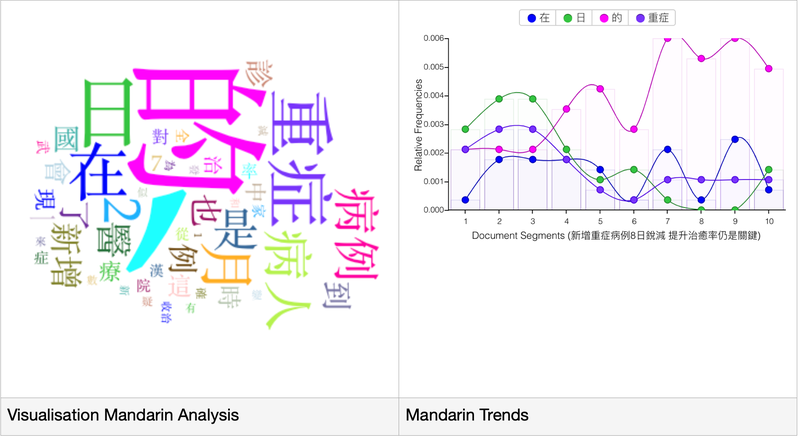Student ambassadors: Maria Jane Marimon | Wing In Choy

Researchers used four research terms: Coronavirus, COVID-19, 新冠肺炎 (Covid-19) and 冠状病毒 (Coronavirus).
The keyword with more results was 新冠肺炎 (Covid-19).
January had no results.
The most common words were:
Enterprise (企业)
Market (市场)
Influence (影响)
Economy (经济)
China (中国)
100 million yuan (亿元)
Industry (行业)
Return to work (复工)
When broken down by month:
February: Enterprise(企业) (Thursdays) and market(市场) (Fridays).
March: the frequency of the term economy(经济)increased as well as government, return to work and China.
April: the term China increased. The most common keywords were industry, income and investment.
COVID-19 was directly correlated with the following keywords: “疫” (8575) (yi) (plague), 情 (8088) (qing) (situation), 企業 (5908) (qi ye) (enterprise), 市場 (4070) (shi chang) (market), 公司 (3582) (gong si) (company), 中國 (3227) (Zhong Guo) (China), 影響 (3029) (sing xiang) (influence), 億元 (2713) (yi yuan) (100m dollars), 肺炎 (2584) (fee can) (pneumonia), 新 (2576) (xin) (new)
Medical jargon is often avoided and abbreviations preferred by newspapers published in Chinese.
Key terms such as 嚴重特殊 傳染性肺炎 (yan zhong te shu chuan ran xing fei yan, or “severe special infectious pneumonia”), “嚴重新型傳染性病原體呼吸系統病” (yan zhong xin xing chuan ran xing bing yuan ti hu xi xi tong bing, or “severe new-type infectious pathogen respiratory disease”) and “嚴重急性 呼吸系統症候群冠狀病毒 2 型” (yan zhong ji xing hu xi xi tong zheng hou qun guan zhuang bing du er xing, or “severe acute respiratory syndrome coronavirus 2” or “SARS‑CoV‑2”) did not yield any results. In other words, they did not appear in any of the available Chinese newspaper sources, including those from China, Malaysia and Singapore.
